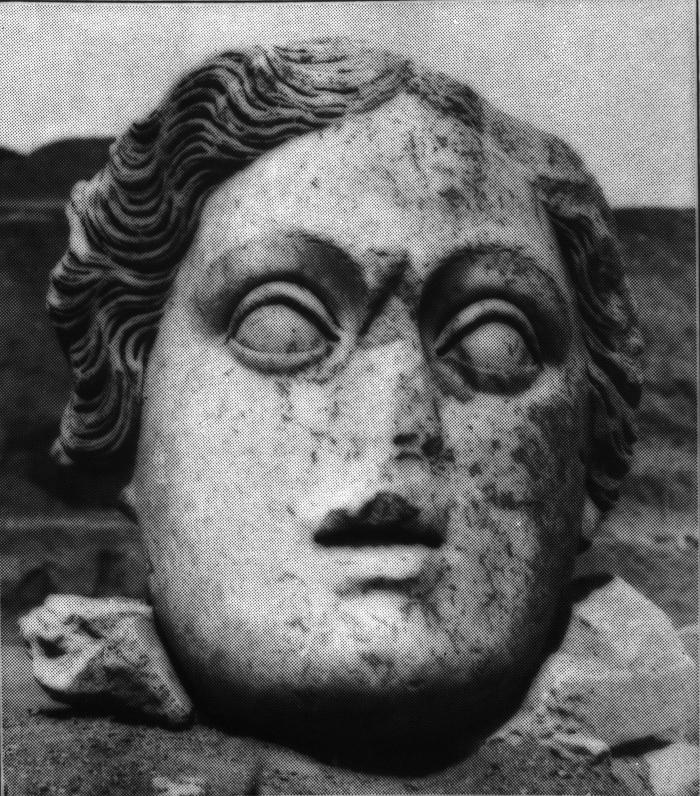-
 Colossal Female Head, Artemis?
Colossal Female Head, Artemis?R2 Cat. 252
Sculpture
Marble, Stone
Ca. 140 AD? (Antonine) (Roman)
The following description is taken from Sardis I, 147: "A colossal sculptured face, very well preserved . . . differs entirely from the similar heads found here; for, though in high relief, it was almost certainly never part of an entire head, but wa...
-
 Horseman Riding toward Altar
Horseman Riding toward AltarR2 Cat. 253
Sculpture
Marble, Stone
(Hellenistic)
The horseman, according to Buckler and Robinson, has a crescent behind his shoulders and therefore represents Mên (ibid.). He wears a short belted tunic with a few minimal diagonal folds. In his r. hand he may hold a short stick. The beginning of the...
-
 Head of a Woman
Head of a WomanR2 Cat. 254
Sculpture
Marble, Stone
AD 218-235 (Roman)
The portrait was worked for insertion into a statue body. The head is turned slightly to the l., and the woman looks upwards, as indicated by the drilled bean-shaped pupils which are placed high within the incised irises. The surfaces of the eyes are...
-
 Bust of Elpidike
Bust of ElpidikeR2 Cat. 255
Sculpture
Marble, Stone
3rd C. AD (Roman)
The bust of a woman is framed by an arched niche with a pilaster on each side, with simple capital and base. The head is turned slightly to the l. Her hair is parted in the middle and drawn behind her ears, where it falls in heavy locks. The drapery,...
-
 Enthroned Mother of the Gods (Cybele)
Enthroned Mother of the Gods (Cybele)R2 Cat. 256
Sculpture
Marble, Stone
2nd or 3rd C. AD (Roman)
Cybele is enthroned and seated between two lions. The arched recess in which she sits suggests a shrine. She wears a high-girt chiton with a V-neck. The transparent cloth reveals her navel and the shape of her breasts. A heavier cloth himation is dra...
-
 Lion-Headed Table Leg
Lion-Headed Table LegR2 Cat. 257
Sculpture
Marble, Stone
2nd or early 3rd C. AD (Roman)
Roaring lion supports a moulded plinth with inscription:
The inscription may refer to erotes or satyrs who carry off jars and food. The piece may have stood against a wall, supporting a shelf.
-
 Head of a Horse
Head of a HorseR2 Cat. 258
Sculpture
Marble, Stone
(Hellenistic)
The head, which is turned slightly to the r., has a close-cropped mane which swings to the l. at the top. The horse's ears were erect. His lively face has small eyes beneath heavy bones, large and distended nostrils, and an open mouth with teeth show...
-
 Seated Cybele
Seated CybeleR2 Cat. 259
Sculpture
Marble, Stone
Late Hellenistic (Roman)
In plan the statue is a not quite regular rectangle with a projection for the feet. Seen from the back, the lines of the base slant to the l. The goddess sits on the high-backed throne with her legs slightly to proper l. She wears a low polos without...
-
 Lid of Sarcophagus of "Pamphylian" Type
Lid of Sarcophagus of "Pamphylian" TypeR2 Cat. 260
Sculpture, Sarcophagus
Marble, Stone
Late 2nd C. AD (Roman)
There are very carefully trimmed rectangular bosses (H. 0.10; W. 0.14) at the centers of both ends of the sarcophagus and two on each side. The pediment has a plain epistyle, fine dentils, a Lesbian cyma, and plain band. A gutter decorated with doubl...
-
 Small Recumbent Lion
Small Recumbent LionR2 Cat. 261
Sculpture
Marble, Stone
early 6th C. BC (Lydian)
The archaic smooth-maned, recumbent lion is facing straight ahead. The head is large and round. The flanks and lower legs are nearly straight and vertical. The ruff and low mane are barely rising over the forehead; there is no trace of a back mane. T...
-
 Funerary Stele, Latin
Funerary Stele, LatinR2 Cat. 262
Sculpture
Marble, Stone
1st C. BC (Hellenistic)
The stele is rectangular with a tenon at the bottom for insertion into another block. Represented on the relief panel are a standing man and woman, three children, and a servant, and in the center background a flat pillar which probably carried an ep...
-
 Hekate
HekateR2 Cat. 263
Sculpture
Marble, Stone
2nd C. AD (Roman)
The three-headed Hekate has a common trunk and polos, and three arms. The faces are badly worn, but are flat, with prominent rounded chins. The hair, parted in the middle, falls in undifferentiated tresses to the shoulders. Breasts are clearly deline...